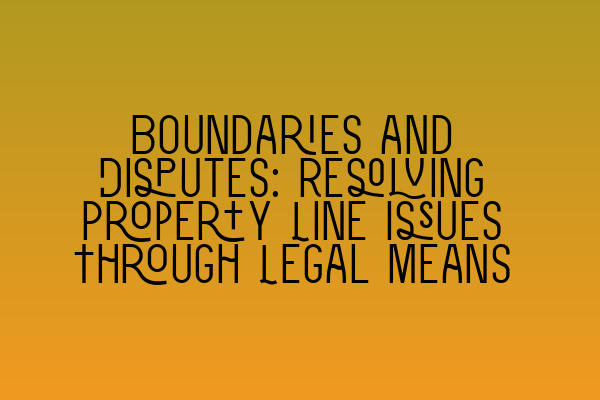Boundaries and Disputes: Resolving Property Line Issues Through Legal Means
As a homeowner or property investor, you understand the importance of clear property boundaries. They not only define the limits of your land but also determine your rights and obligations as a landowner. However, property line issues can arise, leading to disputes with neighboring landowners. Resolving these disputes through legal means is crucial to protect your property rights and maintain peace in your community. In this blog post, we will delve into the topic of boundaries and provide insights into how you can resolve property line issues through legal avenues.
Understanding Property Boundaries
Property boundaries are the lines that separate one property from another. They can be natural features like rivers or trees, man-made structures like fences or walls, or even established legal demarcations. Accurate property boundaries are essential for several reasons. They help ensure that you can fully utilize and enjoy your property without encroaching on your neighbor’s land. Clear boundaries also play a vital role when it comes to buying, selling, or transferring ownership of a property. By having a clear understanding of your property boundaries, you can avoid potential disputes and legal complications.
Common Causes of Property Line Disputes
Property line disputes can arise due to various reasons, often stemming from misunderstandings, misinterpretations, or changes over time. Some common causes include:
1. Unclear Property Descriptions: In some cases, property descriptions in deeds or plans may not be explicit enough, leading to confusion about the exact location of the boundaries.
2. Encroachments: One of the most common causes of property line disputes is when one property owner encroaches onto their neighbor’s land. These encroachments can range from minor infringements such as a fence or hedge crossing over the boundary line to significant structures being built on the wrong piece of land.
3. Easements and Rights of Way: Easements and rights of way are legal rights that allow one party to use a portion of another party’s property. Disputes can arise when the extent or limits of these rights are unclear or violated.
4. Boundary Agreement Disputes: Sometimes, neighboring landowners may have entered into informal agreements regarding their boundaries. However, over time, these agreements can be forgotten or disputed, leading to boundary conflicts.
Resolving Property Line Disputes
When faced with a property line dispute, it is important to address the issue promptly and seek resolution through legal means. Here are some steps you can take:
1. Understand Your Property Rights: Before taking any further action, it is important to thoroughly understand your property rights. Review your property deeds, surveys, and any other relevant documents to gain clarity on your legal boundaries and any easements or rights of way.
2. Communicate with Your Neighbor: In many cases, property line issues can be resolved through open and respectful communication with your neighbor. Reach out to them and discuss the situation to see if a mutual agreement can be reached. It is crucial to remain calm and focused on finding a fair resolution.
3. Engage a Solicitor Specializing in Property Law: If communication fails or the dispute becomes complex, it is advisable to consult a solicitor specializing in property law. They will have the expertise and knowledge to guide you through the legal process, ensuring your rights are protected.
4. Obtain a Professional Survey: In some cases, it may be necessary to commission a professional survey to accurately determine the property boundaries. A survey can provide objective evidence to resolve any disputes and establish the correct boundaries.
5. Mediation or Alternative Dispute Resolution (ADR): In situations where both parties are willing to find a mutually beneficial solution, mediation or ADR can be a viable option. A trained mediator can assist in facilitating a compromise and help avoid lengthy and costly court battles.
6. Litigation: When all else fails, and a resolution cannot be reached through negotiation or mediation, litigation may be necessary. Your solicitor will guide you through the court process, presenting your case to a judge who will make a decision based on the evidence presented.
Conclusion
Resolving property line disputes is crucial for maintaining harmonious relationships with your neighbors and safeguarding your property rights. By understanding your property boundaries, communicating effectively, seeking professional legal assistance, and, if necessary, engaging in mediation or litigation, you can find a fair resolution to your property line issues. Remember, timely action is essential to prevent the escalation of disputes and to protect your interests as a property owner.
If you require further guidance or assistance with property law matters, SQE Property Law & Land Law is here to help. Whether you need advice on property boundaries, easements, or any other property-related issue, our expert solicitors are ready to assist you. Contact us today for a consultation and let us navigate the legal complexities on your behalf.
Related Articles:
– SQE 1 Practice Exam Questions
– SQE 1 Practice Mocks FLK1 FLK2
– SQE 2 Preparation Courses
– SQE 1 Preparation Courses
– SRA SQE Exam Dates
